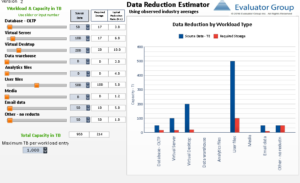This website uses cookies so that we can provide you with the best user experience possible. Cookie information is stored in your browser and performs functions such as recognising you when you return to our website and helping our team to understand which sections of the website you find most interesting and useful.
Since I began my career, I have always used business case models to determine best approaches for everything from comparing acquisition options to the value of implementing new technologies. For Evaluator Group, this has been a way of business as we work with IT Professionals in building their information management and storage strategies. These model-driven engagements have led us to helping vendors determine the best way to articulate the unique value of their new technical and business approaches. Today we are publicly releasing two of these models dedicated to Solid State Storage which unabashedly show off the work of our super smart analysts. These interactive models highlight the impact of some of the latest trends in Solid State Arrays.
The first model focuses on data reduction – what storage efficiencies can you really expect to see when you implement a Solid State Array with compression and  deduplication? We all know that ‘it depends’ on the types of data for your workloads so you can adjust the model’s assumptions based on your environment and decide on how much storage you really need.
deduplication? We all know that ‘it depends’ on the types of data for your workloads so you can adjust the model’s assumptions based on your environment and decide on how much storage you really need.
The second model highlights a fascinating shift in the architectures of the new arrays and the impact of Solid State media. Solid State media has longer lifecycles than HDDs. Thus the idea of de-coupling the lifecycle of an array controller from that of the media can make some sense when acquiring a system. What is the impact? What does it mean to keep solid state media in production for 5, 6 or even 7 years, yet still take advantage of Moore’s law-related performance increases with shorter lifecycles for the array controller? This also changes assumptions built around the frequency of storage media refresh cycles and the need for 3 to 4-year data migrations and their drain on IT resources. Our Economic Interactive Model for “Dissaggregating Controller and Flash” covers the basics, but you will likely want to go deeper and model your environment – and we are here to help.
Play with the models, give us some feedback, and let us know if we can help.
P.S. We have lots of other models we have developed over the years including those for Hybrid Cloud options, Content Repository options (cloud, backup, archive, object), Data Protection approaches and more.
P.P.S. These cool models are Adobe Flash based, thus if using a mobile device you may need to download Puffin browser.

